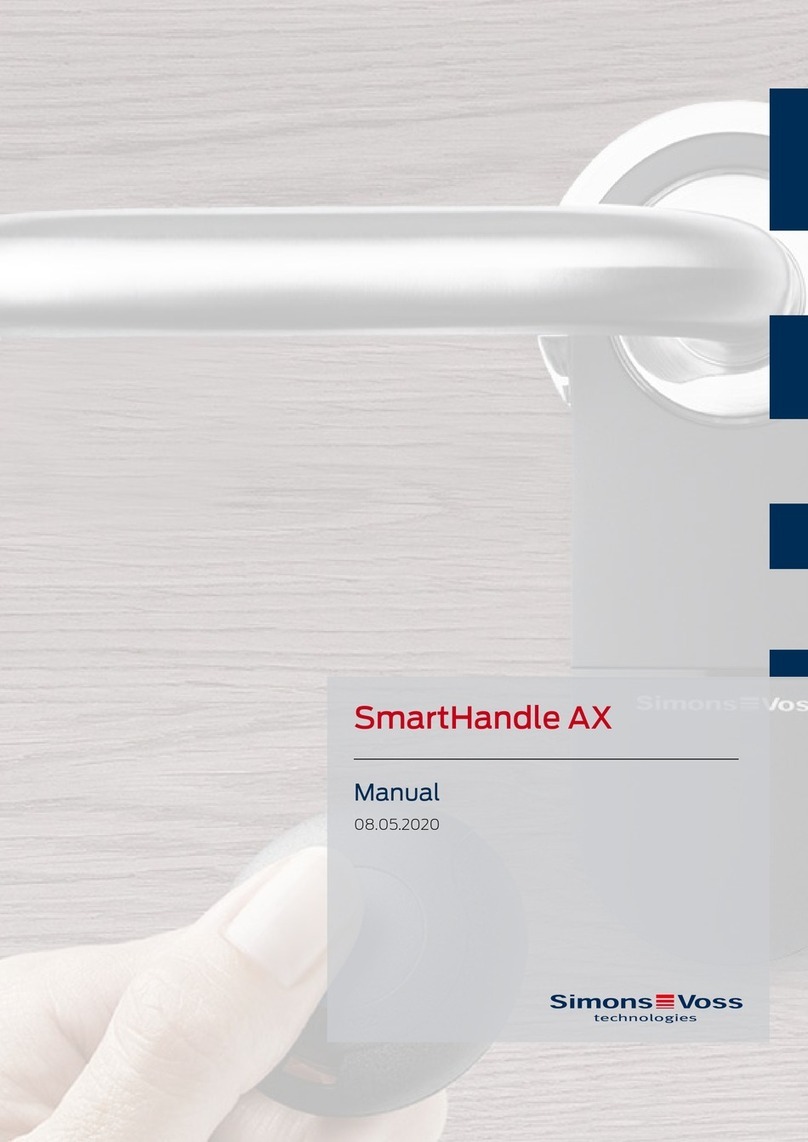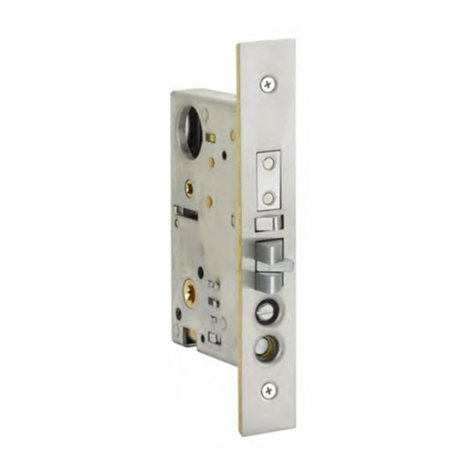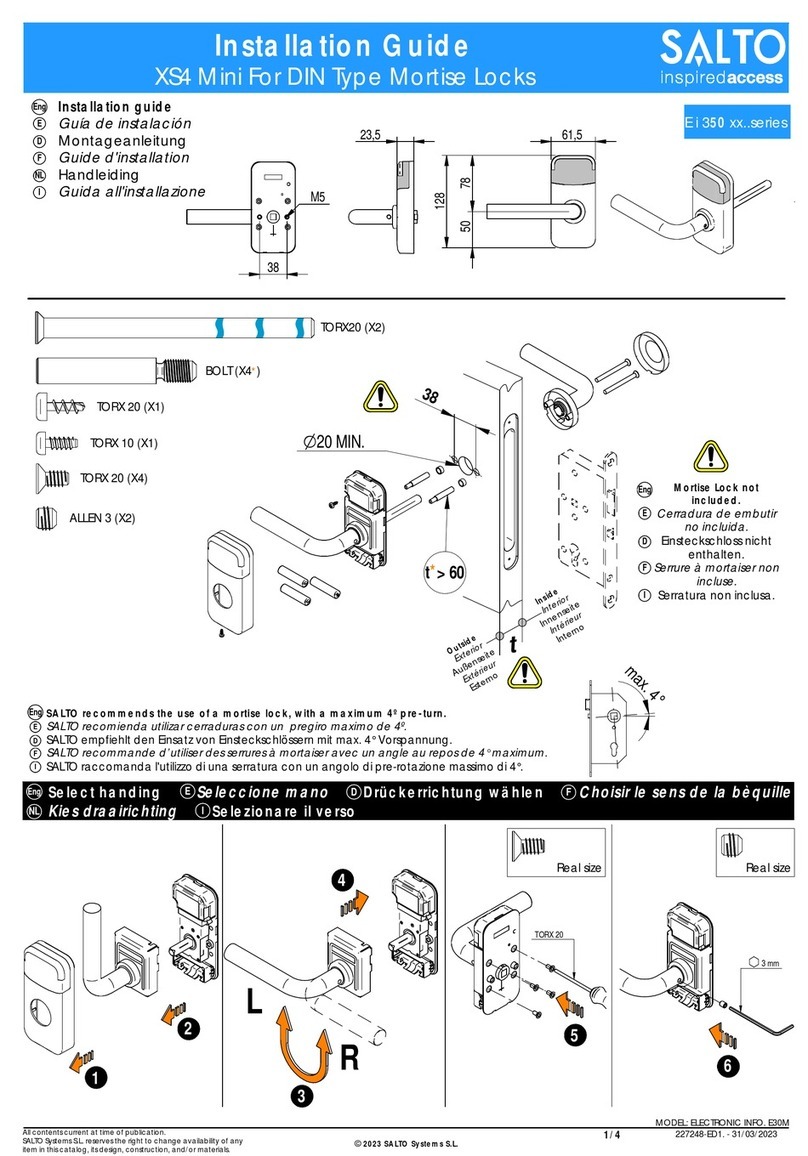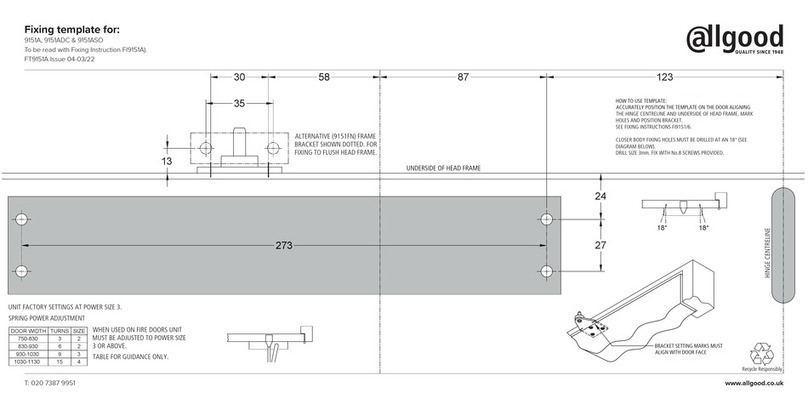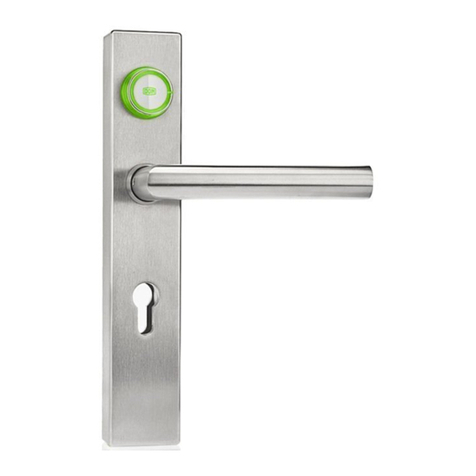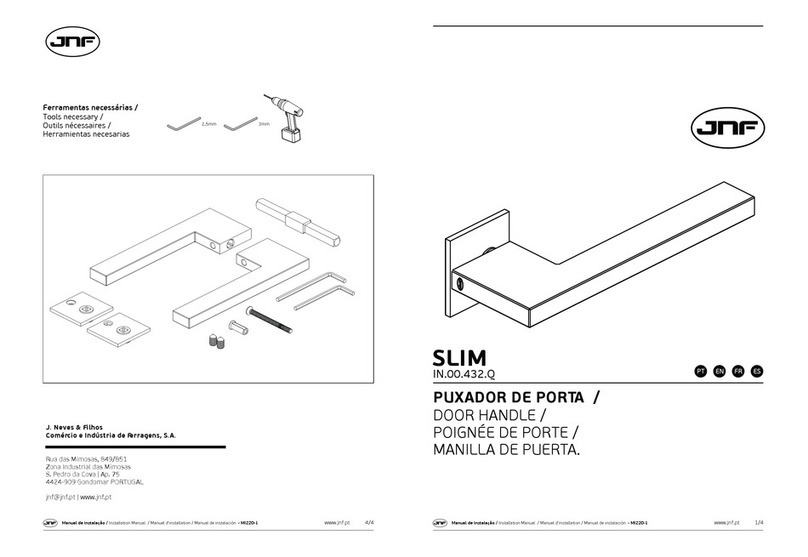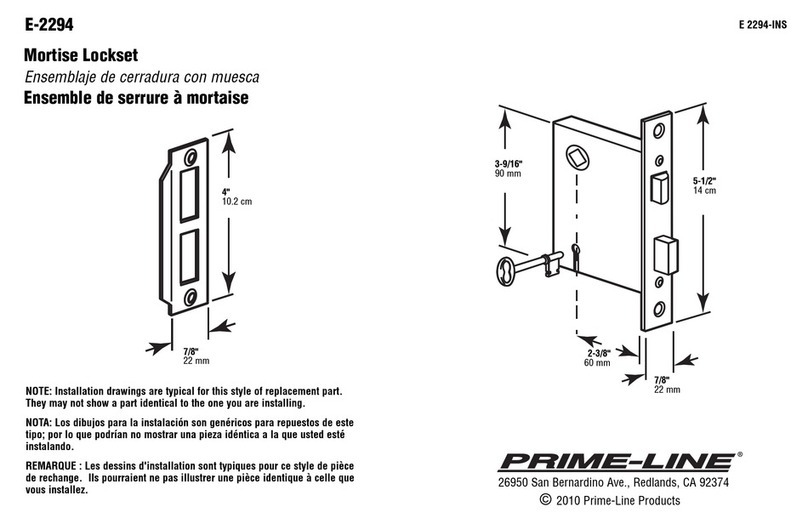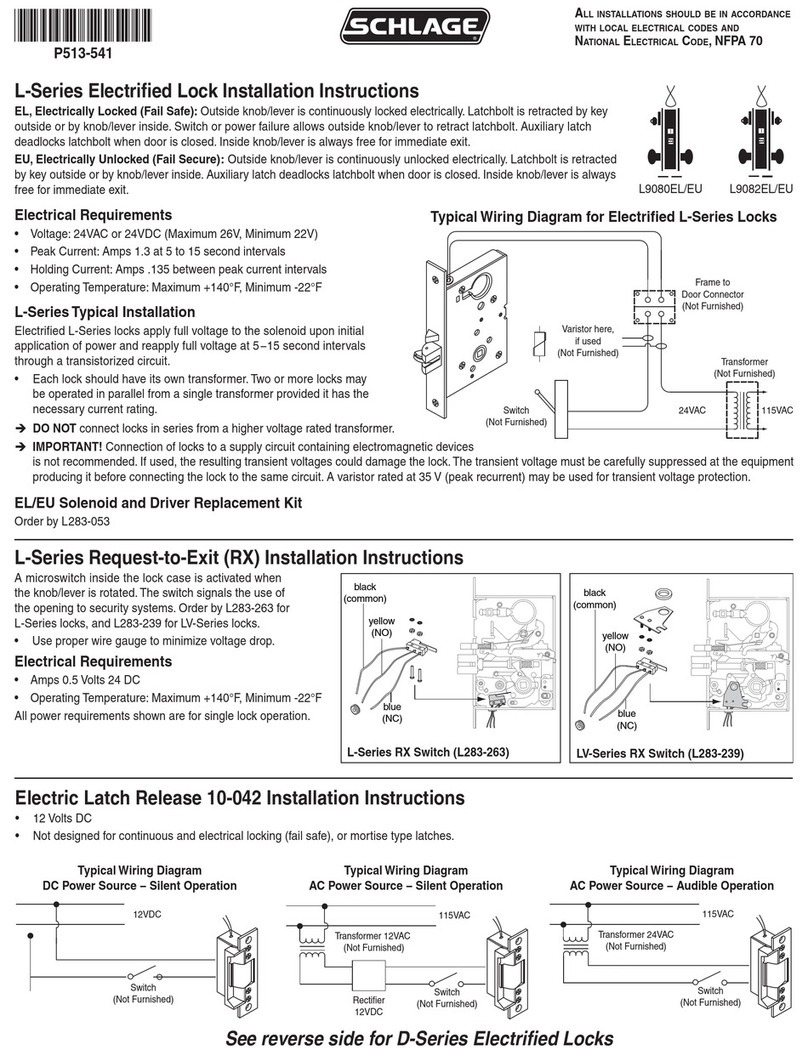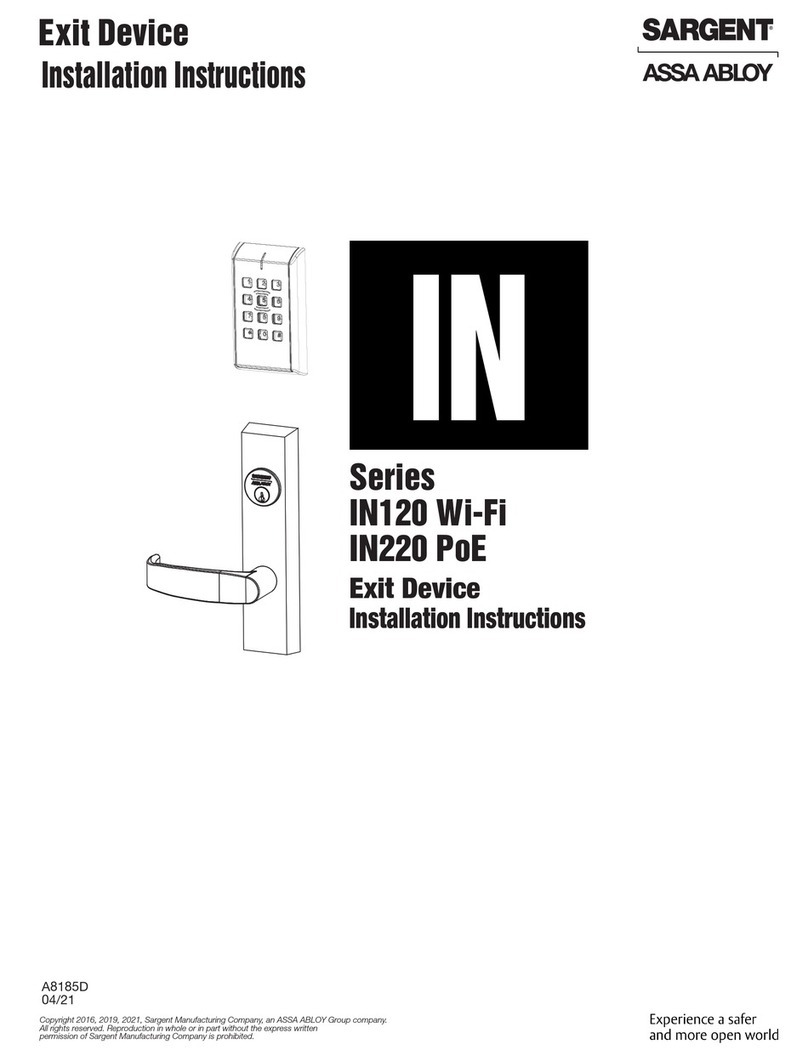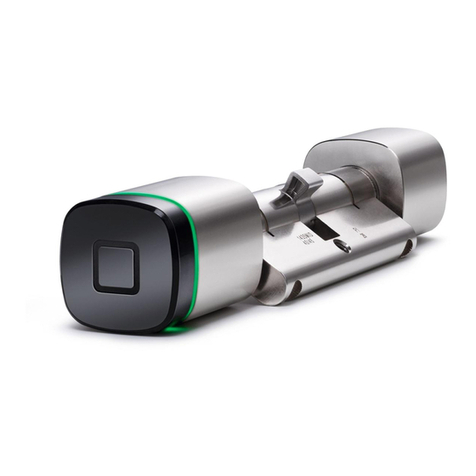Locknetics 101+ Assembly instructions

101+ DELAYED EGRESS MAGNETIC LOCKING SYSTEM
INSTALLATION AND PROGRAMMING MANUAL
575 Birch Street, Forestville, CT 06010
Phone (860) 584-9158 Fax (860) 584-2136
www.locknetics.com
FORM 10111 Rev. C 104/11/2002
PLEASE READ ALL INSTRUCTIONS PRIOR TO INSTALLING THE ELECTROMAGNETIC LOCK.
HANDLE THE EQUIPMENT CAREFULLY, DAMAGING THE MATING SURFACES OF THE
ELECTROMAGNET OR THE ARMATURE MAY REDUCE LOCKING EFFICIENCY.
General Description............................................. 2
Technical Specifications.......................................2
Pre Installation Considerations............................ 3
Door/Frame Prep/Template Information...............4
Mechanical Installation........................................ 6
PC Board Layout and Features........................... 8
Anti Tamper Switch Information...........................8
Dipswitch Settings................................................9
Terminal Layout/Description of Functions............10
101+/101-2+/101+DB Wiring Information............ 11
Monitoring(Alarm,DSM,MBS)/Control Wiring.......11
100CAB/TR80/TR81 Hook-up..............................12
Relock Time Delay............................................... 14
Nuisance Delay....................................................14
Door Propped Delay(SEC)...................................14
Erasing Memory................................................... 14
Creating Master TEK (Computer Programming). 15
“System 7” TouchEntry Key Programming.......... 15
Keypad Initialization.............................................15
Definition of Code/TEK Functions/Defaults..........15
Keypad Manual Programming............................. 16
TouchEntry Key Manual Programming................ 18
TEP1/TEP2 Initialization...................................... 18
Output Audible/Visual/Alarm Indication Table......20
Error Codes..........................................................21
Trouble Shooting..................................................21
Maintenance.........................................................21
Overall Dimensions..............................................22
IMPORTANT! This manual is intended to be kept for programming, maintenance,
and trouble shooting purposes. Do not dispose of this manual after installation.
Please present this manual to the facility manager upon completion of installation.
101+
DELAYED EGRESS
MAGNETIC LOCKING SYSTEM
PUSH UNTIL ALARM SOUNDS.
DOOR WILL OPEN IN 15 SECONDS.
101+DB
101-2+

101+ DELAYED EGRESS
MAGNETIC LOCKING SYSTEM
2
FORM 10111 Rev. C 04/11/2002
TECHNICAL SPECIFICATIONS:
STANDARD MODELS: PWM MODELS:
Dual Voltage: 12 or 24 volts AC or DC (Automatic Selection) 12 volts AC or DC (Automatic Selection)
Max. Current: 0.8 Amps @ 12 Volts (DC) 0.4 Amps @ 12 Volts (DC) ONLY
0.5 Amps @ 24 Volts (DC) 101-2+ and 101+DB MODELS:
12 volts AC or DC (Automatic Selection)
0.8 Amps (total for both magnets) @ 12 Volts (DC) ONLY
Outputs:
Alarm: (standard) N.O. 1.0 Amp resistive load at 30V Alarm: (standard) N.O. 1.0 Amp resistive load at 30V
DSM: (optional) SPDT200mA@12V, 100mA@24V DSM: (optional) SPDT200mA@12V, 100mA@24V
MBS: (optional) SPDT1.0 Amp resistive load at 30V MBS: (optional) SPDT1.0 Amp resistive load at 30V
Audible: 91 dB @ 2 feet
Mechanical Holding Force: 1500 pounds 1200 pounds
Listings: UL SA8954 Special Locking Arrangements MEA 100-99-E, 113-94-E
UL R12092 Builders Hardware - Auxiliary Locks CSFM 3774-0544:105
GENERAL DESCRIPTION: The electromagnet mounts rigidly to the door frame header. The armature mounts to the door. The armature is designed to pivot
about its center compensating for door misalignment. When the door is closed the energized magnet will bond with the armature, providing auxiliary locking force. If the
opening is fire rated, the door must be secured positively with a mechanical latching device, in addition to the magnetic lock, in accordance with local authority having
jurisdiction. Locknetics manufactures fire rated mechanical latching devices. The electronically controlled 101+ series magnetic locks described in this manual share the
same access control circuitry in all models. With optional access control input devices (SelectEntry keypads or TouchEntry Key readers) the locks can hold up to 150
codes standard for access, toggle, lockout, or special function keys. Dry contact inputs allow for fire alarm tie in and remote release/reset capabilities. This manual cov-
ers the mechanical installation, wiring, and manual programming aspects of the locks. For computer programming, see information provided with the software package
you will be using.
THIS MANUAL COVERS THE FOLLOWING MODELS:
101+
Delayed Egress magnet. Delayed egress is initiated by a rocker switch which is actuated by pushing on the door. By setting dipswitches, an auxiliary switch, such as an
exit device or pushbutton, can be used as well. (See dipswitch/terminal layout on page 9.) The nuisance delay can be set from 0-3 seconds in the standard unit (fixed at
1 second in the BOCA unit). The delay time is generally fixed at 15 seconds, but, with approval of the local authority having jurisdiction, can be set to 30 seconds in the
standard unit.
101-2+
Delayed Egress magnet for double doors. Two locks with separate housings, used in applications involving vertical rods or a mullion. This unit has the same features as
the 101+ but one magnet houses a complete controller (master unit) while the other unit has a small interface board for connection to the master unit (slave unit.)
101DB
Delayed Egress magnet for double doors. Two locks in one housing, used in applications involving double doors without vertical rods or a mullion. This unit has the
same features as the 101+.
DESCRIPTION OF OPTIONS:
ATR: Audit Trail Retrieval uses computer programming and interrogation of the lock to store and retrieve time-stamped events such as access, alarm, and reset func-
tions and the time that they occur. 100 events standard (500 with the MX500 option).
BOCA:Some areas adhere to this life safety code for delayed egress. The nuisance delay is fixed at one second and the delayed egress time at 15 seconds. After
delayed egress has been initiated and the door opened, the alarm will automatically reset after 30 seconds. If the door is opened within the 30 seconds the timer will
restart.
DSM: Door Status Monitor will provide status of door with or without power applied. It works by a small permanent magnet, attached to the armature plate (inside an
aluminum block) activates a reed switch located inside the magnetic lock. It is important that the template information be followed carefully to ensure good alignment
between the magnet and the switch.
MBS: Magnetic Bond Sensor will provide status of the lock (locked or unlocked) with or without power applied. It works by way of a factory-calibrated reed switch locat-
ed inside the magnetic lock which senses the strength of the magnetic field. If the voltage is too low or there is some kind of foreign material between the magnet and
armature the MBS output will show a poor bond (even though it may not be possible to force the door open by hand). It is important that the template information be fol-
lowed carefully as poor alignment between he magnetic lock and the armature can cause a poor bond.
MX500: Allows the storage of up to 500 TouchEntry Keys. Will also store the last 500 audit trail events.
PWM: “Power Miser” option. The magnetic lock uses significantly less current so more locks can be loaded onto a power supply. There is a reduction of holding force
to 1200 lbs. as a result of the different magnetic coil used. PWM models can only be operated at 12 volts.
SEC: Security Alarm will sound the onboard horn and close alarm relay contacts if the door is forced open. It will require a manual reset to silence the alarm. If the
door is propped open, or after it is propped open for a selectable time period the lock will sound the onboard horn and close alarm relay contacts. When the door closes
again, the horn will become silent and the alarm will return to its normal (N.O.) state. Anti tailgate is also in effect: the door will relock as soon as it closes, even if the
relock time delay has not yet transpired.

101+ DELAYED EGRESS
MAGNETIC LOCKING SYSTEM
3
FORM 10111 Rev. C 04/11/2002
The electromagnet should be mounted as near to the frame strike jamb as possible
to provide maximum holding force. EXCEPTION: If there is other equipment such
as flush bolt(s) or vertical rod exit device(s) the magnetic lock and its armature can
be shifted accordingly. It should, however, be mounted as close to the strike side
jam as possible without interfering with the operation of the other equipment.
Visually check the mounting location to assure that the unit will mount without inter-
ference. LHR RHR
Wiring for the electromagnet must enter the top of the unit through the wire access hole drilled in the frame header
(see template). Be certain provisions can be made to bring the wire through the header into the top of the unit.
Frame conditions may require the use of filler plates and/or angle
brackets. These items are available from Locknetics. In some cases it
may be necessary to fabricate custom brackets or filler plates to make
a secure installation.
Use proper mounting screws for your door frame. For light-gauge metal door frames, self tapping screws may be used.
If the door frame is heavy-gauge metal, machine screws may be necessary and the holes will have to be tapped.
Caution: It is very important to make sure that magnet is secured to the structure of the opening. It is the responsibility
of the installer to provide structural reinforcement sufficient to ensure a safe installation.
Armature mounting hardware is for door thickness of 1-3/4 inches. Sex nuts for thicker doors are available
from your distributor. For reinforced metal doors the sex nut is not required. Note that it is very important
that the hardware used in mounting the armature is installed correctly. The instructions show clearly how
this must be done. If not done properly, the lock will not function as designed.
PRE-INSTALLATION CONSIDERATIONS
USE OF DELAYED EGRESS LOCKS: Local codes generally require the signage, provided with the product, to be posted on or near the door. Consult local
authority having jurisdiction prior to any installation involving the use of delayed egress products to ensure life safety compliance.
101-2+: When installing 101-2+ models, it does not matter which magnet
(master or slave) gets installed on which leaf of the opening. It will be neces-
sary to run at least four conductors between the two. Approximately 24” of wire
is included as built by the factory. If it is necessary to extend the wires be sure
that a good connection is made.
FRAME STRIKE JAM
PAN HEAD FLAT HEAD
MACHINE
SCREWS
SELF-TAPPING
SCREWS

101+ DELAYED EGRESS
MAGNETIC LOCKING SYSTEM
4
FORM 10111 Rev. C 04/11/2002
INSTALLATION PROCEDURE
A. The door should be closed and latched. You should be at the "push" side. Locate the paper template and fold it along the perforated line with the printed
sides facing each other. Place the template against the frame stop and the door. Tape template in place.
B. On the frame stop mark the location of holes "A" from the template. For heavy gauge or reinforced frames, drill and tap for #10-24 thread. For standard
frames, drill 5/32" dia. for #10 self tapping screws. Locate and drill the 3/4" dia. wire hole. (The 3/4" dia. hole is oversized to the 5/8" dia. mounting plate hole to allow the
full range of adjustability.)
C. On the doors, mark the locations of all holes. Drill (2) 1/4" dia. holes per template for armature guide pins. Armature mounting hole "B" is determined by the
door type (see below).
1. PREP DOOR AND FRAME (FOR STANDARD AND 101-2+ UNITS):
The paper template is the preferable way to prepare the door and frame. If for any reason it is not available, use the dimensions shown below to mark the centerlines of
the holes. Note that the layout is not symmetrical with respect to the centerline of the armature. For 101-2+ units, it does not matter which (master or slave) magnet is
installed on which door. Make sure that wiring can be pulled from one magnet to another. Prep may be shifted to accommodate vertical rod exit devices if necessary.
LH or RHR
RH or LHR
A
B
C
VIEW KEY
A
B
C
VIEW KEY
VIEW A
VIEW B
VIEW C
VIEW A
VIEW B
VIEW C
All dimensions for prep are taken from
the door jamb (soffit) - not the edge of
the door.
All dimensions for prep are taken from
the door jamb (soffit) - not the edge of
the door.

101+ DELAYED EGRESS
MAGNETIC LOCKING SYSTEM
5
FORM 10111 Rev. C 04/11/2002
1. PREP DOOR AND FRAME (FOR 101+DB UNITS):
The paper template is the preferable way to prepare the door and frame. If for any reason it is not available, use the dimensions shown below to mark the centerlines of
the holes. Note that the layout is not symmetrical with respect to the centerline of the armature. The parting centerline of the doors should be used as the center of the
door and frame prep.
HOLLOW METAL DOORWOOD DOOR REINFORCED METAL DOOR 2. DRILL 1/2” DIA. HOLE
INTO SKIN OF DOOR ON
SEX NUT SIDE ONLY. DO
NOT DRILL THROUGH
DOOR.
1. DRILL 11/32” DIA.
HOLE THROUGH
DOOR.
DRILL AND TAP
FOR 5/16-18
MACHINE
SCREW.
HEX KEY
STAR LOCKING
WASHER
TAPERED
WASHER
SEX NUT
DRILL 1/2” DIA
THRU HOLE.
FLAT WASHER (WOOD DOORS ONLY)
HOLE “B” FOR MOUNTING ARMATURE IS DETERMINED BY DOOR TYPE:
PARTING LINE OF DOORS
ARMATURE MOUNTING HOLE INFORMATION (ALL MODELS):

101+ DELAYED EGRESS
MAGNETIC LOCKING SYSTEM
6
FORM 10111 Rev. C 04/11/2002
3. ATTACH MOUNTING PLATE AND
ALIGNING TEMPLATE TO HEADER
Slotted holes and counterbore should face downward.
Mount to the frame using (2) #10-24 x ½" pan head
machine screws, or (2) #10 x 3/4" pan head self-tapping
screws, and #10 flat washers. Tighten screws just tight
enough to allow shifting the plate during adjustment.
Install plastic aligning template onto mounting plate using
flat head machine screws. Note the direction of the door
face.
DOOR
STAR LOCKING
WASHER
TAPERED WASHER
ARMATURE
SEX NUT
DSM BLOCK
(OPTIONAL. REQUIRED ON MODELS
WITH DSM, SEC, AND/OR BOCA
OPTIONS)
2. MOUNT ARMATURE TO DOOR
Assemble using hardware provided in the order shown.
All hardware shown must be used except where noted.
Note that the tapered washer must be placed with the
pointed side facing away from the door and toward the
armature. It MUST be used for proper operation. Use
hex key to tighten the armature mounting bolt. For solid
core and hollow metal doors, gently tap sex nut into posi-
tion with a rubber mallet before mounting armature
assembly. Proper use of hardware will allow armature to
pivot slightly after securely tightening the mounting
screw. This is normal, and necessary to allow armature
to mate properly with magnet.
CAUTION:
Failure to secure armature to door may result in serious
injury to door user. For proper operation, safety and
security, sex nut / bolt assembly, washers and spacers
must be assembled in the order illustrated and securely
tightened 1/8 to 1/4 turn past hand tight.
FLAT WASHER
(WOOD DOORS
ONLY)
4. ALIGN PLATE TO ARMATURE USING PLASTIC ALIGNING TEMPLATE
Close door. Push template/mounting plate assembly toward door until it comes against the armature leaving no gap. Tighten pan head screws completely. Mark the posi-
tion of the mounting plate. Remove plastic alignment template from the mounting plate without moving the mounting plate. Remove plastic template.
PUSH HERE TO
CLOSE GAP
101+DB
101+DB

101+ DELAYED EGRESS
MAGNETIC LOCKING SYSTEM
7
FORM 10111 Rev. C 04/11/2002
5. SECURE MOUNTING PLATE
Using the Mounting Plate as a template, drill the four (or eight for 101+DB)
remaining mounting holes.
If using #10 self-tapping, flat-head screws drill 5/32" dia. holes and drive
four screws tight.
If using #10-24 flat head machine screws, drill and tap for #10-24 threads
and tighten four screws.
CAUTION: If the frame is wood it is critical that the screws used secure the
mounting plate to the structure of the frame. It is the responsibility of the
installer to provide sufficient reinforcement for
a safe installation.
6. SECURE MAGNET TO MOUNTING PLATE
Install the electromagnet to the mounting plate using the two 1/4-20 x 2" socket head
cap screws with a hex key. Firmly tighten the screws. Pass wiring through hole in top
of magnet and through access hole on circuit board side of magnet as shown below.
Drive in anti-tamper plugs using a rubber mallet. (It is advisable to wait until the mag-
net is wired and tested before installing anti-tamper plugs in case the magnet position
must be adjusted.)
NOTE: For 101-2+ see wiring information on page 11 to wire between units.
8. FASTEN ELECTRONICS COVER AND LOCK GUARD
After wiring and programming (or if it is to be done later) fasten
the electronics cover(s) and lock guard(s) to the magnet. After
verifying that the unit works correctly install anti-tamper plugs, if
desired. Note that they will need to be drilled out if the lock
must be removed or adjusted.
7. MAKE FINAL WIRING CONNECTIONS, SET DIPSWITCHES, AND PROGRAM LOCK
(SEE WIRING AND PROGRAMMING BEGINNING ON PAGE 8)
Refer to the wiring and programming section of this manual. If wiring and programming is to be done by someone else(besides the person doing the mechanical installa-
tion) please make sure that this manual is given to that person. DO NOT DISCARD THIS MANUAL. IT IS IMPORTANT THAT IT BE GIVEN TO THE OWNER OR
BUILDING MAINTENANCE MANAGER FOR REFERENCE AFTER INSTALLATION.
101+DB
101+DB
101+DB

101+ DELAYED EGRESS
MAGNETIC LOCKING SYSTEM
8
FORM 10111 Rev. C 04/11/2002
SW-4
(DIP SWITCHES 1-8)
LED
ATR CHIP
(OPTIONAL)
HORN
ACCESS CONTROL
TERMINAL BLOCK-
KEYPAD (100CAB)
OR
TEK READER INPUT
ON-BOARD
TEK READER
ATS
ANTI-TAMPER
SWITCH LOCATION
(OPTIONAL - NOT
SHOWN)
MAIN TERMINAL BLOCK
SW-2
SW-1
FIRE ALARM
INTERFACE
CONFIGURA-
TION SWITCH
SW-3
PC BOARD LAYOUT AND FEATURES:
Connect wiring to main terminal strip. If the unit is to be used with a KP70+ series keypad or TR83/84 TouchEntry Key reader (and the required 100CAB adapter cable)
or a TR80 or TR81 see the wiring information on page 12 and the programming information starting on page 14. After wiring, time delay setting, initialization and pro-
gramming have been completed, secure the cover onto the lock.
See next page (9)for terminal layouts and dipswitch settings. Not all terminals will be used in all cases. Note that to get the correct outputs the correct options must have
been ordered and the dipswitches set properly.
IMPORTANT: DO NOT APPLY POWER UNTIL ALL CONNECTIONS HAVE BEEN MADE AND DIPSWITCHES SET AND VERIFIED.
SW-1 Fire Alarm Interface dipswitch. Configures whether there is a normally open or a normally closed input from the fire panel (see next
page for setting dipswitches).
SW-2/SW-3 These switches are used to set the various time delays and for memory reset. (See “Time delay settings” on page 14.)
SW-4 This bank of 8 dipswitches is used to configure various features of the system. See next page for setting dipswitches. Note that they
are numbered from 1 (on the bottom) to 8 (on the top) and Left is ON and right is OFF.
Main Terminal Block This terminal block has 18 screw terminals. See page 10 for description of terminal functions and wiring information.
Access Control Terminal Block Used to interface Locknetics 3-wire cable/keypad system (100CAB adapter cable with keypad) or to hook up a TR80 or TR81
TouchEntry Key reader.
Horn Provides local audible indication of alarm status and programming signals. (See chart on page 20 “Table of Outputs”.)
LED Tri-color LED (red, yellow, green) used to provide local visual indication of alarm status. (See chart on page 20 “Table of Outputs”.)
On-Board TEK reader If TouchEntry keys are to be used for egress control and alarm reset the on-board TEK reader is provided.
ATR chip/socket (Requires computer management) The ATR option provides a record of past access, alarm, and reset events along with the time and
person. If the chip must be added in the field, it must be installed in the socket with the larger side facing away from the PC board.
Once installed, memory will need to be erased before the lock will recognize the chip. See page 14 for memory reset information.
ATS (Anti-Tamper Switch) The ATS option monitors the status of the electronics cover. When the cover is removed the unit goes into alarm. It must be reset by
entering a valid code or TEK, or by entering a reset input into terminals 17 &18. (NOTE: on 101+DB and 101-2+ models the ATS on
the slave unit is not wired directly into the PC board, rather, it has form C contacts with flying leads.)

101+ DELAYED EGRESS
MAGNETIC LOCKING SYSTEM
9
FORM 10111 Rev. C 04/11/2002
8ONSW-4 DIPSWITCH SETTINGS OFF
7
6
5
4
3
2
3
2
3
2
1
DISABLED
DISABLED
DISABLED
DISABLED
DISABLED
30 SEC.
ENABLED
ENABLED
ENABLEDNUISANCE ALERT: Horn sounds when door pushed to alert people that door is armed. Avoids false alarms.
AUTOMATIC RELOCK: Door locks upon power up or after fire alarm. If set to OFF: manual reset required.
DOOR FORCED / DOOR PROPPED ALARM (SEC OPTION ONLY)
UNLOCK ALERT: Horn sounds whenever door is unlocked (and still has power applied to it).
ANTI-TAILGATE (SEC OPTION ONLY): When door closes it immediately relocks (cancels time delay).
EGRESS DELAY TIME: This is the time that the door will remain locked and in alarm before it unlocks.
SWITCH #
ENABLED
ENABLED
15 SEC.
x
x
xx
x
x
3
2x
x
x
x
BY ON-BOARD ROCKER SWITCH ONLY (DEFAULT)
BY ROCKER SWITCH OR AUXILIARY INPUT
BY ROCKER SWITCH AND AUXILIARY INPUT
DELAYED EGRESS DISABLED.
CONFIGURE HOW
THE DELAYED
EGRESS EVENT IS TO
BE TRIGGERED,
USING DIPSWITCHES
2 & 3
SW-1
SW-1 TO RIGHT FOR N.O. OR NO CONNECTION:
SW-1 TO LEFT FOR N.C. CONNECTION:
SW-1 FIRE ALARM INPUT:
To configure interface to terminals 3&4
on main terminal block.
CONFIGURE FIRE ALARM INTERFACE DIPSWITCH (SW-1) FOR CORRECT TYPE OF INPUT.
A dry contact is required. It can be normally open or normally closed. If no direct connection is to be made, configure the input for normally open (SW-1 to RIGHT).
CONFIGURE THE SW-4 DIPSWITCHES TO SET THE FUNCTIONS OF THE SYSTEM.
Power should not be applied at this time. Note that dipswitches 4 and 6 are specifically for the SEC option. Also note that dipswitch 7 must be “on” for the lock to auto-
matically lock when powered up, or after a fire alarm condition. If it is off, the lock will remain unlocked, with the LED green, when power is applied. In order to lock it, a
reset input or valid code or TEK will be required after power up or after a fire alarm condition.

101+ DELAYED EGRESS
MAGNETIC LOCKING SYSTEM
10
FORM 10111 Rev. C 04/11/2002
ALARM CONDITION RESET INPUT: Apply a normally open, momentary, dry contact which closes, shorting 17 and 18, when activated.
This input will reset an alarm condition (except for a fire alarm condition, which is controlled by the status of the input on terminals 3 &4). If the lock is
in delayed egress alarm (but before it actually unlocks) and a reset input is entered, it will cancel the remaining delayed egress time and unlock but
still remain in alarm. An additional contact closure event will be required in this case in order to reset the lock back to the locked condition and cancel
the alarm condition. This is because delayed egress is required to be an irreversible sequence of events resulting in the door becoming unlocked.
Once the door unlocks the alarm condition can be reset to the locked position.
IMPORTANT! DO NOT APPLY POWER TO TERMINALS 17 & 18 OR DAMAGE MAY RESULT.
1
10 (C)
2
3
4
5
6
7 (C)
8 (NO)
11 (NC)
9 (NO)
POWER INPUT: Apply 12 or 24 volts (AC or DC). The lock will adjust for input.
IMPORTANT NOTES:
a. PWM and double units (101-2+ and 101+DB can ONLY accept 12 volts)
b. Polarity does not matter in this case
FIRE ALARM INPUT: Apply a normally closed or normally open dry contact from fire panel or other emergency system. Be sure that the wiring
complies with authority having jurisdiction. Note that SW-1 (located on PC board) may have to be configured for proper operation. (See page 9)
IMPORTANT! DO NOT APPLY POWER TO TERMINALS 3 & 4 OR DAMAGE MAY RESULT.
AUXILIARY INPUT: This terminal is used in cases where it is desired that an additional device (such as an exit device) be used in addition to or
instead of the on-board rocker switch to initiate the delayed egress cycle. Apply a normally open dry contact to terminals 5 & 6 which closes when
activated, thereby shorting 5 to 6. The SW-4 dipswitches 2 & 3 will need to be set for proper operation. (See page 9).
IMPORTANT! DO NOT APPLY POWER TO TERMINALS 5 & 6 OR DAMAGE MAY RESULT.
ALARM OUTPUT: Terminals 7 & 8 close when an alarm condition exists. The following conditions will close the output: delayed egress alarm
condition, fire alarm condition, 20 wrong keypad entries, delete (user) with alarm, door forced (SEC only), door propped (SEC only). Note that during
the nuisance delay (grace period before the delayed egress cycle begins) the alarm contacts do not change state, even if the on-board horn is sound-
ing.
15
16
REQUEST TO EXIT INPUT: Apply a normally open dry contact which closes, shorting 15 and 16, when activated. When the request to exit
device is released, the lock will relock after the relock time delay (See page 14 to adjust).
IMPORTANT! DO NOT APPLY POWER TO TERMINALS 15 & 16 OR DAMAGE MAY RESULT.
17
18
DSM OUTPUT (REQUIRES DSM OPTION): Door Status Monitor. “Normal” refers to the door being open. When the door is closed, the
contacts change state.
13 (C)
14 (NC)
12 (NO) MBS OUTPUT (REQUIRES MBS OPTION): “Normal” here refers to the magnet being unlocked. When the magnet is properly locked,
the contacts change state. If they do not, there are several possible causes: low voltage, dirt or debris between the magnet and armature, damage to
the mating surfaces, or improper alignment between the armature and magnet.
MAIN TERMINAL BLOCK:
N.O. INPUT FROM CARD
READER, BUTTON, ETC.
ON TERMINALS 15 & 16
JUMPER ON
TERMINALS 16 & 17
WIRING TRICK: if using a keyswitch, card reader or other dry-
contact input device where there is only one set of contacts
available, the following trick can be used: place a jumper across
terminals 16 and 17 and put the N.O. input across terminals 15
& 16. This will allow one set of input contacts to both release
and reset the lock, depending on the condition.

101+ DELAYED EGRESS
MAGNETIC LOCKING SYSTEM
11
FORM 10111 Rev. C 04/11/2002
101+ BASIC WIRING:
101-2+ and 101+DB
REQUIRED WIRING:
101-2+ DOOR STATUS(DSM):
101-2+ LOCK STATUS (MBS):
On the 101-2+ model the flying leads provided for wiring between units can be extended as required. Make sure that a
good connection is made. The anti-tamper switch(ATS option) for the slave unit has flying leads whereas the ATS for the
master unit is wired directly to the PC board and will sound the on-board alarm.
On 101+DB units, do not change or modify the factory-installed wiring.

101+ DELAYED EGRESS
MAGNETIC LOCKING SYSTEM
12
FORM 10111 Rev. C 04/11/2002
WIRING OF LOCKNETICS KEYPADS/TOUCHENTRY KEY READERS
Up to two Locknetics keypads or TouchEntry Key readers can be hooked up to a 101+ or 101-2+ system for access control and alarm reset input.
Any keypad or TR83/TR84 hook up requires a 100CAB adapter cable. The three-wire 100CAB allows the keypad to be initialized to the lock or allows the TR83/TR84 to
be properly connected. Using the 770CAB (a Locknetics 12-wire adapter cable) does not work! Only one 100CAB can be used. Two keypads or TR83/TR84 readers can
be plugged into a single 100CAB. If the installation requires more distance between the two keypads/readers, an AUXCAB1 or AUXCAB16 can be used to extend the
keypad/reader cables.
If the installation involves TR80 or TR81 TouchEntry Key readers then the two readers must be wired in parallel. 80CAB adapter cables can be used.
100CAB
(REQUIRED)
AUXCAB1 OR AUXCAB16
(RECOMMENDED FOR TWO KEYPADS)
100CAB
(REQUIRED)
80CAB
(REQUIRED)
AUXCAB1 OR AUXCAB16
(RECOMMENDED FOR TWO KEYPADS)
WHITE
BLACK
RED
WHITE
BLACK
RED
WHITE
BLACK
RED
TR80/TR81
HOOK-UP
TR83/TR84
HOOK-UP
KP70+
HOOK-UP

101+ DELAYED EGRESS
MAGNETIC LOCKING SYSTEM
13
FORM 10111 Rev. C 04/11/2002
NOTES:

101+ DELAYED EGRESS
MAGNETIC LOCKING SYSTEM
14
FORM 10111 Rev. C 04/11/2002
MANUAL PROGRAMMING OF TIME DELAYS:
RELOCK TIME DELAY (factory default: 8 seconds)
The amount of time the lock is de-energized after release by entering a valid code/TEK or
Programmable 1-30 seconds.
A. Set SW4 dipswitch #6 to OFF (if it is on).
B. Press and release SW2. The LED will begin flashing GREEN .
C. Thereafter, press SW3 once for each second of relock delay desired.
(ex. 3 presses equals 3 seconds-15 presses equals 15 seconds-Up to 30 seconds)
Each SW3 activation will cause the LED to flash RED and the horn to beep .
D. Press SW2 and the relock delay will be stored in non-volatile memory.
E. Return SW4 dipswitch #6 to its original position (if you moved it in step A).
NOTES: 1. Not pressing SW3 between pressing SW2 will set the relock time delay to zero seconds. This will cause the lock not to unlock with a
momentary contact closure or valid code or TEK. A TIME DELAY OF MORE THAN ONE SECOND IS RECOMMENDED.
2. Models with the SEC option include the anti-tailgate feature. If SW4-4 is on, the lock will relock immediately when the door closes
even if the time delay has not yet expired.
NUISANCE DELAY (factory default: 3 seconds)
The amount of time the door must be pushed before triggering the DELAYED EGRESS CYCLE
Programmable 0 - 3 seconds. (BOCA Units are fixed at 1 second.)
A. Press and release SW3, the LED will begin flashing RED.
B. Thereafter, press SW2 once for each second of nuisance delay desired, up to 3 seconds maximum.
Each SW2 activation will cause the LED to flash GREEN and the horn to beep .
C. Press SW3 and the nuisance delay will be stored in non-volatile memory.
NOTES: 1. To program nuisance delay to zero, eliminate Step B.
2. Setting nuisance delay to zero will allow the lock to go into delayed egress the instant the door is pushed. This may prove
inconvenient in some applications.
DOOR PROPPED DELAY (factory default: 60 seconds)
The amount of time the door must be propped open (after normal release time delay has ended) before triggering the alarm. The alarm will clear as soon as the door
closes again. Programmable 0 - 120 seconds.
A. Set SW4-6 to ON (if it is off).
B. Press and release SW2, the LED will begin flashing YELLOW.
C. Thereafter, press SW3 once for each second of propped delay desired, up to 120 seconds maximum.
Each SW3 activation will cause the GREEN LED to flash and the horn to beep .
D. Press SW2 and the door prop delay will be stored in non-volatile memory.
E. Leave SW4-6 ON to enable door propped alarm.
NOTES: 1. To program door propped delay to zero, eliminate Step B.
2. Setting the door propped delay to zero will cause the lock to go into alarm the instant that the normal time delay has ended, if the door
is still open.
ERASE MEMORY (MEMORY RESET)
Memory may be erased to conveniently return to default time delay settings or if an error was made.
A. Press and hold SW2 until a single beep is heard. Release SW2.
B. Quickly press SW2 three times, three beeps will sound.
C. Another 3 beeps will sound in about 10 seconds indicating the memory is erased.
NOTES: 1. All programmed codes and keys will be erased. Factory default codes and time settings will be restored.
2. Keypads using a 100CAB (for direct connection to 101+ lock) will need to be initialized again.

101+ DELAYED EGRESS
MAGNETIC LOCKING SYSTEM
15
FORM 10111 Rev. C 04/11/2002
TO CREATE MASTER TEK (FOR USE WITH COMPUTER PROGRAMMING)
The master TEK is used to initialize programming (like a password to access programming mode).
A. Set SW4 dipswitch #1 to ON (if it is off).
B. Press and hold SW3 until two beeps are heard.
C. Touch a TEK key to the reader within ten seconds. The lock will indicate acceptance with two beeps. This will be the Master TEK.
D. Return SW4, #1 to its original position.
NOTES: 1. Refer to instructions included with the programmer/software that you will use to program for more
information regarding programming.
2. The Master TEK is used for initiating programming. It will not unlock the door.
3. Unlike some other Locknetics products, creating a master TEK will not delete the factory default codes.
They must be manually deleted.
“SYSTEM 7” PROGRAMMING:
This procedure will allow up to seven TouchEntry Keys to be programmed into a lock equipped with a TouchEntry Key reader of SelectEntry Keypad. Keys will be of the
Normal Access type and will unlock the unit for the relock time delay. The TEKs will also reset the lock if it is in an alarm condition.
A. Set SW4-1 to OFF (if it is on)
B. Press and hold SW3 until you hear two beeps. Release SW3.
C. Touch each of the TEKs to the reader. Two quick beeps will sound each time a key has been accepted.
D. After entering up to seven TEKs wait 10 seconds for programming to end. One quick beep will indicate that programming has ended.
E. Return SW4-1 to its original position, if required.
NOTE: Whenever new “System 7” TEKs are entered, the old ones are erased. Also, whenever computer programming is done, or memory is erased, all “System 7”
TEKs are erased.
KEYPAD/100CAB INITIALIZATION (REQUIRED TO ENABLE KEYPAD TO FUNCTION)
It is necessary to initialize the keypad/100CAB any time that the memory is erased.
A. Set SW4 dipswitch #1 to ON.
B. Press and hold switch SW3 for two quick beeps of the audible..
C. Push each button in order, starting with the 1-2 button, and including the *.
* Wait for LEDs to stop flashing before pushing next button.
* Waiting for longer than 7 seconds will terminate initialization.
D. After the last button is pressed, the audible will beep three times and the LEDs will
flash indicating that programming has ended.
E. Return SW4 dipswitch #1 to its original position.
DEFINITION OF CODE/TEK FUNCTIONS AND FACTORY DEFAULTS:
MASTER 97531 Allows access to programming functions. Will not release lock.
NORMAL 13579 Unlocks lock for relock time delay. Will reset lock in alarm condition.
ACCESS
TOGGLE 135135 Unlocks the lock until same or another Toggle Code is entered.
LOCKOUT 9115 “Freezes” the lock in its present condition, either locked or unlocked, until the same or
another Lockout Code/TEK is entered.
ONE-TIME ACCESS No factory default. This type of code/TEK will allow access only once.
It will then become deleted from memory.
SUPERVISED ACCESS No factory default. This type of code/TEK allows access only when used with another
Supervised Access Code/TEK. The second code/TEK must be entered within five
seconds of the first one. The order that they are entered does not matter.
FACTORY DEFAULT

101+ DELAYED EGRESS
MAGNETIC LOCKING SYSTEM
16
FORM 10111 Rev. C 04/11/2002
TO CHANGE CODES
Master Code *...1 *...Old Code*...New Code (3-8 digits) *...*(to end)
MORE CODES CAN BE CHANGED
BY RETURNING HERE.
TO DELETE CODES WITH ALARM/ATR NOTICE:
Codes will be not be allowed to function but will remain in memory. When the code is used, the lock will go into alarm, the alarm relay will close, the audible
will sound and the LED will illuminate red. The door will not unlock. It will stay in alarm until a valid user code, TouchEntry Key or reset input will silence the
alarm. If the ATR option is present and the unit was programmed by computer, an access attempt will show in the audit trail.
Master Code *...55 *...Old Code *...*(to end)
MORE CODES CAN BE DELETED
BY RETURNING HERE.
TO DELETE CODES
Master Code *...5 *...Old Code *...*(to end)
MORE CODES CAN BE DELETED
BY RETURNING HERE.
MANUAL PROGRAMMING - KEYPAD
When manually programming the 101+ model lock, using a keypad, the keypad must first be initialized. It is a recommended that the factory default Master Code be
changed. Doing so will delete all factory default codes and ensure the security of the system. After entering the Master code the LEDs on the keypad will flash. They will
also flash each time that *is entered. Wait for the LED to stop flashing before entering the next sequence.
TO CHANGE MASTER CODE
Master Code *...7 *...New Master Code (5-8 digits)*...New Master Code *
TO ADD NORMAL ACCESS CODES - Will unlock door for relock time delay period. Will also reset lock after an alarm condition.
Master Code *...3 *...New Code (3-5 digits) *...*(to end)
UP TO 150 NEW CODES CAN BE
ADDED BY RETURNING HERE.

101+ DELAYED EGRESS
MAGNETIC LOCKING SYSTEM
17
FORM 10111 Rev. C 04/11/2002
TO ADD TOGGLE CODES(Note that a three digit function code ‘131’ sets the function of the user code)
Master Code *...33*...131*...New Access Code (3-8 digits) * ...*(to end)
UP TO 150 NEW CODES CAN BE ADDED BY RETURNING HERE.
TO ADD LOCKOUT CODES(Note that a three digit function code ‘115’ sets the function of the user code)
Master Code *...33*...115*...New Access Code (3-8 digits) * ...*(to end)
UP TO 150 NEW CODES CAN BE ADDED BY RETURNING HERE.
TO ADD ONE-TIME ACCESS CODES(Note that a three digit function code ‘113’ sets the function of the user code)
Master Code *...33*...113*...New Access Code (3-8 digits) * ...*(to end)
UP TO 150 NEW CODES CAN BE ADDED BY RETURNING HERE.
TO ADD SUPERVISED ACCESS CODES(Note that a three digit function code ‘117’ sets the function of the user code)
Master Code *...33*...117*...New Access Code (3-8 digits) * ...*(to end)
UP TO 150 NEW CODES CAN BE ADDED BY RETURNING HERE.
TO CHANGE FUNCTION/CODES
Master Code *...11*...Old Code *... X Y Z *...New(or same) Code (3-8 digits) *...*(to end)
New or Same
3-digit function
code.See above.

101+ DELAYED EGRESS
MAGNETIC LOCKING SYSTEM
18
FORM 10111 Rev. C 04/11/2002
MANUAL PROGRAMMING - TOUCHENTRY
When manually programming the 101+ model lock for TouchEntry Keys, a programmer (either the TEP1 or TEP2) must first be initialized. Only one programmer can be
initialized to a particular lock. A Master TEK must also be initialized at the same time as the programmer and will be used to enter the programming mode. See steps
below. After entering the Master TEK the green LED on the TouchEntry Key reader will flash. It will also flash each time that *is entered. Wait for the LED to stop flash-
ing before entering the next sequence. The TEP1 and TEP2 programmers are intended to simulate a keypad.
PROGRAMMER INITIALIZATION TEP1 AND TEP2
A. Set SW4 dipswitch #1 to ON.
B. Press and hold switch SW2 for two quick beeps of the audible..
C. Touch a TEK key up to the reader. (This TEK will be initialized as a MASTER TEK.)
D. Touch each TEK of the TEP1 to the reader in the following order(two beeps of the
audible will sound indicating acceptance of each key.)
(For TEP2 plug communication plugs into ports and push each button in order)
* Wait for LEDs to stop flashing before touching next key or pushing next button.
* Waiting for longer than 7 seconds will terminate initialization.
E. After the last key/button is entered, the audible will beep three times and the LEDs will
flash indicating that programming has ended.
F. Return SW4 dipswitch #1 to its original position.
TO DELETE TEKs
Master TEK...5 *...Old PIN*...*(to end)
MORE TEKs CAN BE DELETED BY
RETURNING HERE.
TO DELETE TEKs (WITH ALARM/ATR NOTICE): TEKs will be not be allowed to function but will remain in memory.
When the TEK is used, the lock will go into alarm, the alarm relay will close, the audible will sound and the LED will illuminate red. The door will not
unlock. It will stay in alarm until a valid user code, TouchEntry Key or reset input will silence the alarm. If the ATR option is present and the unit was pro-
grammed by computer, an access attempt will show in the audit trail.
Master TEK...55 *...Old PIN*...*(to complete)
MORE TEKs CAN BE DELETED
BY RETURNING HERE.
TO ADD NORMAL ACCESS TEKS - Will unlock door for relock time delay period. Will also reset lock after an alarm condition.
Master TEK...3 *...New PIN(3-8 digits)*...New Access TEK...*(to complete)
UP TO 150 NEW TEKs CAN BE
ADDED BY RETURNING HERE.

101+ DELAYED EGRESS
MAGNETIC LOCKING SYSTEM
19
FORM 10111 Rev. C 04/11/2002
TO ADD TOGGLE TEKs (Note that a three digit function code ’131’ sets the function of the user TEK)
Master TEK ...33*...131*...New PIN(3-8 digits)*...New Toggle TEK ...*(to end)
UP TO 150 NEW TEKs CAN BE ADDED BY RETURNING HERE.
TO ADD LOCKOUT TEKs (Note that a three digit function code ’115’ sets the function of the user TEK)
Master TEK ...33*...115*...New PIN(3-8 digits)*...New Lockout TEK ...*(to end)
UP TO 150 NEW TEKs CAN BE ADDED BY RETURNING HERE.
TO ADD ONE-TIME ACCESS TEKs (Note that a three digit function code ’113’ sets the function of the user TEK)
Master TEK ...33*...113*...New PIN(3-8 digits)*...New One-time Access TEK ...*(to end)
UP TO 150 NEW TEKs CAN BE ADDED BY RETURNING HERE.
TO ADD ONE-TIME ACCESS TEKs (Note that a three digit function code ’117’ sets the function of the user TEK)
Master TEK ...33*...117*...New PIN(3-8 digits)*...New One-time Access TEK ...*(to end)
UP TO 150 NEW TEKs CAN BE ADDED BY RETURNING HERE.
TO CHANGE FUNCTION AND/OR PIN
Master TEK ...11*...Old PIN*... X Y Z *...New(or same) PIN (3-8 digits) *...*(to end)
New or Same
3-digit function
code.See above.

101+ DELAYED EGRESS
MAGNETIC LOCKING SYSTEM
20
FORM 10111 Rev. C 04/11/2002
DESCRIPTION OF INDICATORS
CONDITION LED INDICATOR AUDIBLE ALARM RELAY
STATE (TERM.7&8)
STANDARD FEATURES
LOCK SECURE OFF OFF OPEN
LEGAL RELEASE INPUT STEADY GREEN OFF OPEN
LOW INPUT VOLTAGE OFF SLOW BEEP OPEN
DURING NUISANCE DELAY STEADY YELLOW OFF(DEFAULT)
(SET BY SW4-8) OPEN
DURING DELAYED EGRESS FLASHING RED BEEPING CLOSED
AFTER DELAYED EGRESS STEADY GREEN STEADY TONE CLOSED
ANTI-TAMPER ALARM
IF LOCK COVER IS REMOVED
(ON MASTER UNIT ONLY –
SLAVE ATS HAS FLYING LEADS)
STEADY
RED STEADY
TONE CLOSED
SWITCH SELECTABLE FEATURES
SW4-5 “ON” =UNLOCK ALARM
WHENEVER LOCK IS UNLOCKED STEADY
GREEN STEADY
TONE OPEN
SW4-8 “ON” = HORN WILL SOUND
DURING NUISANCE ALERT STEADY
YELLOW ON OPEN
OPTIONAL SWITCH SELECTABLE FEATURES
SEC (SECURITY ALARM OPTION) REQUIRED
SW4-6 “ON” DOOR PROPPED
OPEN ALARM
DOOR IS HELD OPEN PAST
RELOCK TIME
FLASHING
GREEN BEEPING CLOSED
SW4-6 “ON” DOOR FORCED
OPEN ALARM
DOOR OPENED WITHOUT VALID
RELEASE SIGNAL
FLASHING
RED BEEPING CLOSED
PROGRAMMING INDICATIONS
RELOCK DELAY PROGRAMMING
ACTIVE FLASHING
GREEN OFF OPEN
DOOR PROPPED OPEN DELAY FLASHING YELLOW OFF OPEN
WHILE PRESSING SW3 0R SW2
TO SET RELOCK AND DOOR
PROPPED DELAYS RED CHIRP OPEN
NUISANCE DELAY
PROGRAMMING ACTIVE FLASHING RED OFF OPEN
WHILE PRESSING SW2 TO SET
NUISANCE DELAY GREEN CHIRP OPEN
TABLE OF INDICATORS (LED/AUDIBLE)
The table below is intended to provide all possible indications and states which can be encountered under normal operation. Note
that some conditions or features are only available on certain models or when certain options are included.
This manual suits for next models
2
Table of contents
Popular Door Lock manuals by other brands
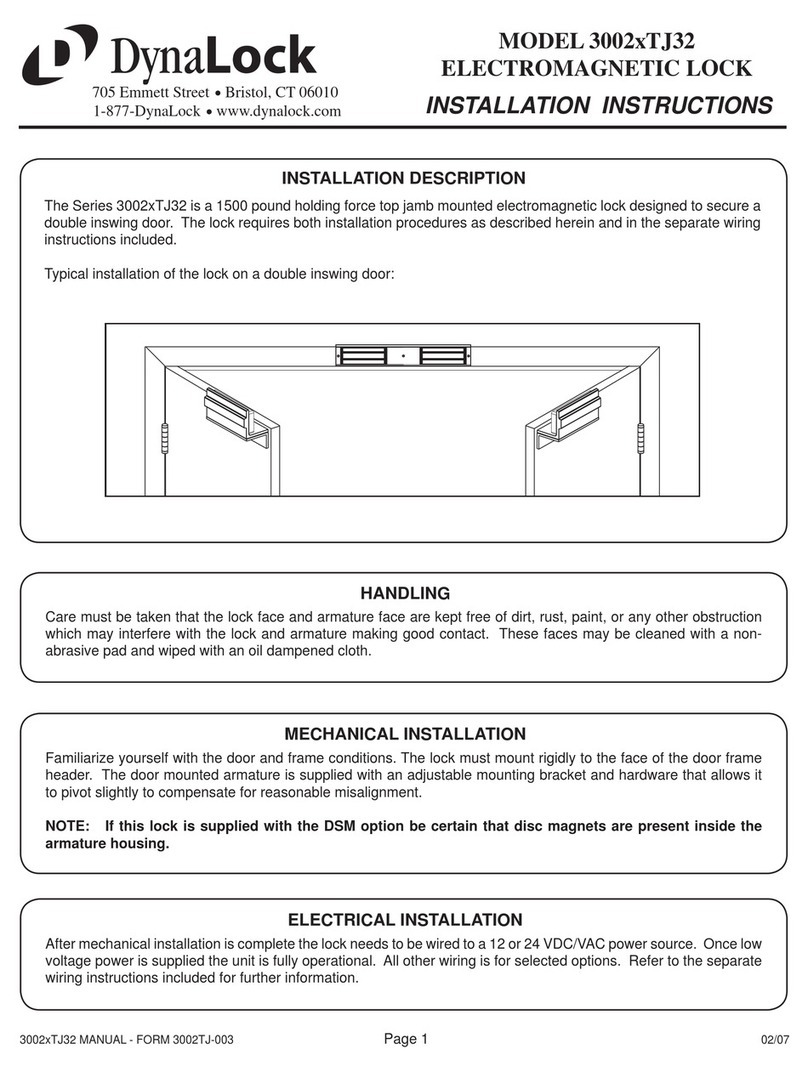
DynaLock
DynaLock 3002 TJ32 Series installation instructions
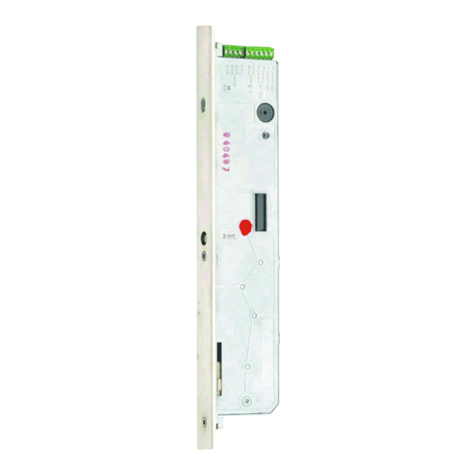
Siegenia-AUBI
Siegenia-AUBI KFV Genius Assembly instructions
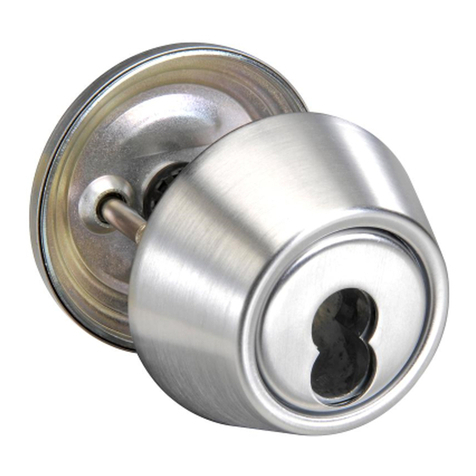
Yale
Yale D100 Series installation instructions

Kaba
Kaba 7102 series installation instructions
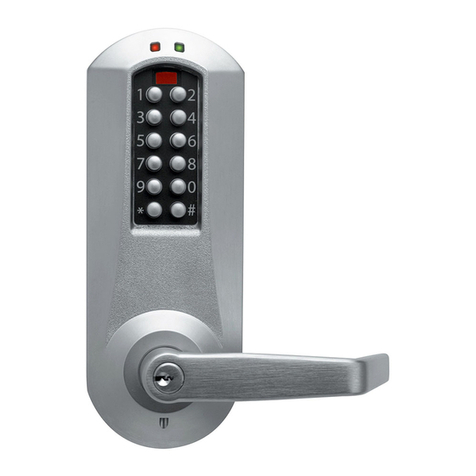
Kaba
Kaba E-PLEX STANDARD Series user guide
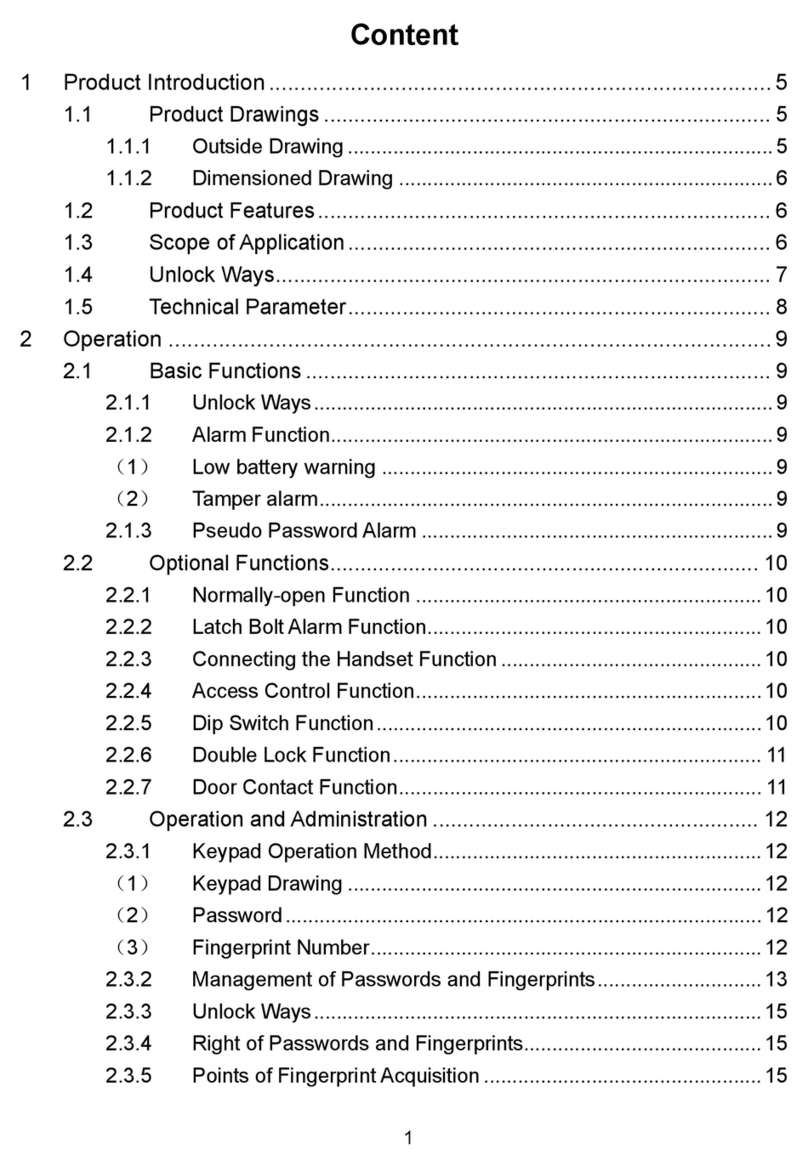
FingerprintDoorLocks
FingerprintDoorLocks U10 manual
